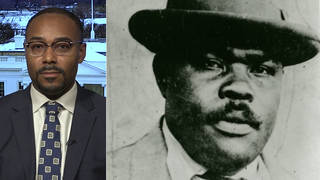
Guests
- Rosemary Harris Lytlepresident of the NAACP Colorado, Montana, Wyoming State Conference, and former head of the Colorado Springs branch of the NAACP.
The FBI says a deliberate explosion outside a Colorado office of the NAACP may have been an act of domestic terrorism. An improvised explosive device was detonated on the NAACP building’s wall in Colorado Springs Tuesday morning. A gasoline can was placed nearby, but did not ignite. An FBI spokesperson says a hate crime is among the potential motives. Police have announced a person of interest in the case, a white male around the age of 40. According to the Southern Poverty Law Center, the NAACP has been the target of eight bombings since 1965, including three in 1993, when the last attacks occurred. We speak to Rosemary Harris Lytle, president of the NAACP Colorado, Montana, Wyoming State Conference, and former head of the Colorado Springs branch of the NAACP.
Transcript
JUAN GONZÁLEZ: We turn now to Colorado, where the FBI says a deliberate explosion outside a Colorado office of the NAACP may have been an act of domestic terrorism. An improvised explosive device was detonated on the NAACP’s building wall in Colorado Springs Tuesday morning. A gasoline can was placed nearby but did not ignite. An FBI spokesperson says a hate crime is among the potential motives. Police have announced a person of interest in the case, a white male around the age of 40.
The bombing of the building, the nation’s oldest civil rights group, has received almost no attention in the corporate media. According to the website ThinkProgress, a search of news coverage over a close to 24-hour period through Wednesday afternoon found just one mention on CNN and none on MSNBC and Fox News. MSNBC’s Al Sharpton and Chris Hayes did cover the explosion on their programs Wednesday evening.
AMY GOODMAN: According to the NAACP, the attack follows the shooting of a school bus that was traveling with the group’s 120-mile protest march in Missouri last month. On Wednesday, NAACP President Cornell Brooks posted a message in response to the explosion near the group’s Colorado Springs office.
CORNELL BROOKS: Thankfully, the NAACP family is safe. Whenever I think about the bombing in Colorado Springs, I’m reminded that, whenever threatened, the NAACP doubles down for justice.
AMY GOODMAN: According to the Southern Poverty Law Center, the NAACP has been the target of eight bombings since 1965, including three in 1993, when the last attacks occurred. The FBI is expected to give a news conference this afternoon on the explosion in Colorado Springs, along with the BATF, the Bureau of Alcohol, Tobacco, Firearms and Explosives.
For more, we go directly to Colorado Springs, where we’re joined by Rosemary Harris Lytle, the president of the NAACP Colorado, Montana, Wyoming State Conference, former head of the Colorado Springs branch of the NAACP.
Welcome to Democracy Now! Can you tell us what happened?
ROSEMARY HARRIS LYTLE: Well, good morning. What we do know, based on police reports and based on the reports of those who were in the NAACP office in Colorado Springs on Tuesday morning, that at approximately 10:45 there was an explosion, there was an improvised explosive devise that was placed against the exterior wall of the building, that it did cause an explosion that greatly disturbed the flow of community, the harmony of community. One described it as a shotgun blast directly to his ear, in its loudness. And we know that law enforcement authorities—FBI, local police and others—are now investigating and looking for that person of interest, and hopefully they, in their work, will help us know who did this and why.
JUAN GONZÁLEZ: Was there any indication beforehand of any threats against that particular branch of your organization or any reason why that would occur in Colorado Springs?
ROSEMARY HARRIS LYTLE: Well, I think that any time organizations are involved in the kind of work that the NAACP is involved in, any of its units can be placed into jeopardy as a backlash to that activism. We do have some anecdotal evidence of those who might have been disturbed by some of the activities of the NAACP, whether nationally or in the state or even locally at this branch office, but none of that has been verified as the precursor to the kind of criminal act that we saw on Tuesday.
AMY GOODMAN: The Southern Poverty Law Center’s Mark Potok said several NAACP offices have been attacked since the '80s. He spoke on MSNBC's The Ed Show.
MARK POTOK: In 1981, for instance, an NAACP office was attacked. In 1989, an NAACP lawyer in Savannah was murdered with a letter bomb. There was an attack with a tear gas bomb on the Atlanta headquarters of the NAACP in the early '80s. And it really goes on and on. It's been quite something.
AMY GOODMAN: That was Mark Potok. Rosemary Lytle, if you could just wrap up in talking about your concerns right now and in this climate today, as we look at what happened in Ferguson, in Staten Island, the racial climate in the United States?
ROSEMARY HARRIS LYTLE: Well, as we think about the long history of racial division in this country, going back to the most racially divisive thing that might have happened on this planet—the forced importation of African slaves to this country—I think that knowing that we’ve never talked about that as a country, knowing that we’ve never had a national moment of truth and reconciliation, knowing that we typically have responses to events in this country, whether they were the bombing of four little girls in a church or a bomb being placed under the bed of an NAACP president and his wife on Christmas Eve in 1951, or even what we were talking about from the Southern Poverty Law Center just now, we know that at the heart of these problems is the lack of a conversation on race.
It also has not happened in Colorado Springs, an enormously beautiful place, full of people who, I believe—I’ve lived here for almost 20 years—are of good conscience, started by General William Jackson Palmer, who fought slavery in the North and founded this city as a place that would be completely inclusive, but very quickly became a place of restrictive covenants, became a sundown town, became a place that was inhabited by those from the South who could not accept that kind of complete equity and inclusion in public life, and is one of the reasons why the NAACP was born here in 1981—excuse me, in 1918, in 1918, when founder Mary White Ovington came to charter the NAACP Colorado Springs branch at the local church that had been started, the first bricks given by General Palmer, the Payne Chapel AME. So we know that the history of strife and division in this country, even in this pretty little place, Pikes Peak, a place that’s storied in its beauty, underneath that is an ugliness that we’ve talked about and that I, as a journalist, have written about since I’ve moved here.
AMY GOODMAN: Rosemary Harris Lytle, I want to thank you for being with us, and we’ll certainly continue to cover this story, president of the NAACP Colorado, Montana, Wyoming State Conference, former head of the Colorado Springs branch of the NAACP, speaking to us from Colorado Springs.













Media Options